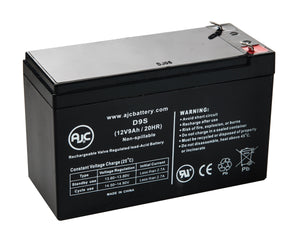Types of Lead Acid Batteries
Sealed lead acid batteries are still used today because they are an inexpensive and reliable power source. Over the 140 years since the invention of the lead acid battery, various modifications and improvements have been made.
Wet Cell Batteries
Wet cell batteries are the oldest version of lead acid battery, and are either serviceable or maintenance free. Serviceable batteries have vented, removable caps so the electrolyte can and should be checked regularly. This type of battery is the least expensive, and may last longer if properly maintained. However, they must be installed in a particular orientation, and can present a danger from leaking acid if damaged.
Maintenance free batteries are sealed for life and as the name implies, the water level does not need to be maintained or monitored. These batteries are much safer, but still must be installed upright and could present a danger from leaking acid if damaged.
Both types of wet cell batteries are somewhat temperature sensitive since the electrolyte solution can freeze or evaporate. They are also prone to gassing, which means they produce Hydrogen sulfide, a poisonous, flammable gas if overcharged.
Sealed Lead Acid Batteries
Valve Regulated Lead Acid (VRLA) batteries, or Sealed Lead Acid (SLA) batteries are safer and more forgiving of ambient temperature changes than wet cell batteries. They are designed to prevent evaporation of the electrolyte, and that prolongs battery life and reduces gassing. The two types of Sealed Lead Acid batteries are Absorbed Glass Mat (AGM) and Gel batteries.
Gel batteries were developed in the 1950’s in Germany, and were popular in the 1970’s. A silica-gelling agent is added to the sulfuric acid electrolyte liquid to turn it into a paste, making the electrolyte gel like and immobile, and the battery maintenance free. They are mainly used for UPS (uninterruptable power supply) systems. They work reliably in higher temperatures than other batteries, and they can be mounted in any direction. They last longer than other batteries, and they operate near their peak output for a longer time, until they quickly drop off.
AGM batteries, also called dry cell batteries or sealed lead acid batteries, came into wide use in the 1980’s because they were lighter and more reliable than wet cell or gel batteries for specific applications. An AGM battery is similar to a wet cell battery, except the electrolyte is being held next to the plates in the fiberglass mats, as opposed to freely flooding the plates. Like gel batteries, this makes the AGM battery spill proof, as the acid is contained within the matting technology. They are more vibration resistant, and can withstand colder temperatures than a typical wet cell battery. They cost a little more, and are sensitive to overcharging, which can make them un-suitable for some applications.
AGM batteries outsell gel batteries. They are less expensive, and they are easier to recharge. They also offer more available power for the size. Gel batteries are more useful in applications where the temperature is hotter and a slower rate of discharge is a priority.
Wet Cell Batteries
Wet cell batteries are the oldest version of lead acid battery, and are either serviceable or maintenance free. Serviceable batteries have vented, removable caps so the electrolyte can and should be checked regularly. This type of battery is the least expensive, and may last longer if properly maintained. However, they must be installed in a particular orientation, and can present a danger from leaking acid if damaged.
Maintenance free batteries are sealed for life and as the name implies, the water level does not need to be maintained or monitored. These batteries are much safer, but still must be installed upright and could present a danger from leaking acid if damaged.
Both types of wet cell batteries are somewhat temperature sensitive since the electrolyte solution can freeze or evaporate. They are also prone to gassing, which means they produce Hydrogen sulfide, a poisonous, flammable gas if overcharged.
Sealed Lead Acid Batteries
Valve Regulated Lead Acid (VRLA) batteries, or Sealed Lead Acid (SLA) batteries are safer and more forgiving of ambient temperature changes than wet cell batteries. They are designed to prevent evaporation of the electrolyte, and that prolongs battery life and reduces gassing. The two types of Sealed Lead Acid batteries are Absorbed Glass Mat (AGM) and Gel batteries.
Gel batteries were developed in the 1950’s in Germany, and were popular in the 1970’s. A silica-gelling agent is added to the sulfuric acid electrolyte liquid to turn it into a paste, making the electrolyte gel like and immobile, and the battery maintenance free. They are mainly used for UPS (uninterruptable power supply) systems. They work reliably in higher temperatures than other batteries, and they can be mounted in any direction. They last longer than other batteries, and they operate near their peak output for a longer time, until they quickly drop off.
AGM batteries, also called dry cell batteries or sealed lead acid batteries, came into wide use in the 1980’s because they were lighter and more reliable than wet cell or gel batteries for specific applications. An AGM battery is similar to a wet cell battery, except the electrolyte is being held next to the plates in the fiberglass mats, as opposed to freely flooding the plates. Like gel batteries, this makes the AGM battery spill proof, as the acid is contained within the matting technology. They are more vibration resistant, and can withstand colder temperatures than a typical wet cell battery. They cost a little more, and are sensitive to overcharging, which can make them un-suitable for some applications.
AGM batteries outsell gel batteries. They are less expensive, and they are easier to recharge. They also offer more available power for the size. Gel batteries are more useful in applications where the temperature is hotter and a slower rate of discharge is a priority.
Find Your Replacement Battery
Browse our website to see if we have a match for your replacement battery
Browse Batteries

